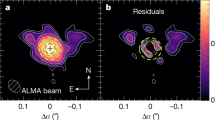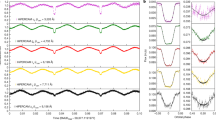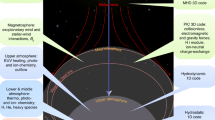Abstract
Massive planets have now been found orbiting about 80 stars. A long outstanding question critical to theories of planet formation has been the timescale on which gas-giant planets form; in particular, stars more massive than the Sun may blow away the surrounding gas associated with their formation more quickly than it can be accumulated by the protoplanetary cores1. Evidence for a protoplanet around a Herbig AeBe star (such stars are 2–3 times more massive than the Sun) would constrain the timescale of planet formation. Here we report the detection of CO and H3+ emission from the 5–10-million-year-old Herbig AeBe star HD141569. We interpret the CO data as indicating that the inner disk surrounding the star is past the early phase of accretion and planetesimal formation, and that most of the gas has been cleared out to a distance of more than 17 astronomical units. CO effectively destroys H3+ (ref. 2), so their presence in the same source is surprising. Moreover, H3+ line emission has previously been detected only from the atmospheres of the giant planets in the Solar System3,4. The H3+ and CO may therefore be distributed in the disk at different circumstellar distances, or, alternatively, H3+ may be located in the extended envelope of a protoplanet.
This is a preview of subscription content, access via your institution
Access options
Subscribe to this journal
Receive 51 print issues and online access
$199.00 per year
only $3.90 per issue
Buy this article
- Purchase on Springer Link
- Instant access to full article PDF
Prices may be subject to local taxes which are calculated during checkout



Similar content being viewed by others
References
Natta, A., Grinin, V. & Mannings, V. in Protostars and Planets IV (eds Mannings, V., Boss, A. P. & Russell, S. S.) 559–588 (Univ. Arizona Press, Tucson, 2000)
Oka, T. A search for interstellar H3+. Phil. Trans. R. Soc. Lond. A 303, 543–549 (1981)
Maillard, J. P., Drossart, P., Watson, J. K. G., Kim, S. J. & Caldwell, J. H3+ fundamental band in Jupiter's auroral zones at high resolution from 2400 to 2900 cm-1. Astrophys. J. 363, L37–L41 (1990)
Drossart, P. et al. Detection of H3+ on Jupiter. Nature 340, 539–541 (1989)
Fisher, R. S., Telesco, C. M., Piña, R. K., Knacke, R. F. & Wyatt, M. C. Detection of extended thermal infrared emission around the Vega-like source HD 141569. Astrophys. J. 532, L141–L144 (2000)
Weinberger, A. J. et al. The circumstellar disk of HD141569 imaged with NICMOS. Astrophys. J. 525, L53–L56 (1999)
van den Ancker, M. E., de Winter, D. & Tjin A Djie, H. R. HIPPARCOS photometry of Herbig Ae/Be stars. Astron. Astrophys. 330, 145–154 (1998)
Zuckerman, B., Forveille, T. & Kastner, J. H. Inhibition of giant planet formation by rapid gas depletion around young stars. Nature 373, 494–496 (1995)
Malfait, K., Bogaert, E. & Waelkens, C. An ultraviolet, optical and infrared study of Herbig Ae/Be stars. Astron. Astrophys. 331, 211–223 (1998)
Weinberger, A. J., Rich, R. M., Becklin, E. E., Zuckerman, B. & Matthews, K. Stellar companions and the age of HD 141569 and its circumstellar disk. Astrophys. J. 544, 937–943 (2000)
Tokunaga, A. T., Toomey, D. W., Carr, J., Hall, D. N. B. & Epps, H. W. Proc. Instrumentation in Astronomy VII 131–143 (Society of Photo-Optical Instrumentation Engineers, Bellingham, WA, 1990)
Thi, W. F. et al. H2 and CO emission from disks around T Tauri and Herbig Ae pre-main-sequence stars and from debris disks around young stars: warm and cold circumstellar gas. Astrophys. J. 561, 1074–1094 (2001)
Ruden, S. P. & Pollack, J. B. The dynamical evolution of the protosolar nebula. Astrophys. J. 375, 740–760 (1991)
Lissauer, J. J. Planet formation. Annu. Rev. Astron. Astrophys. 31, 129–174 (1993)
Podolak, M., Hubbard, W. B. & Pollack, J. B. in Protostars and Planets III (ed. Levy, E. H.Lunine, J. I.) 1109–1147 (Univ. Arizona Press, Tucson, 1993)
Miller, S., Tennyson, J. & Joseph, R. D. Infrared emission of H3+ in the atmosphere of Jupiter in the 2.1 and 4.0 μm region. Astrophys. J. 360, L55–L58 (1990)
Oka, T. & Geballe, T. R. Observations of the 4 μm fundamental band of H3+ in Jupiter. Astrophys. J. 351, L53–L56 (1990)
Trafton, L. M., Geballe, T. R., Miller, S., Tennyson, J. & Ballester, G. E. Detection of H3+ from Uranus. Astrophys. J. 405, 761–766 (1993)
McCall, B. J., Geballe, T. R., Hinkle, K. H. & Oka, T. Observations of H3+ in dense molecular clouds. Astrophys. J. 522, 338–348 (1999)
McCall, B. J., Hinkle, K. H., Geballe, T. R. & Oka, T. H3+ in dense and diffuse clouds. Faraday Discuss. 109, 267–280 (1998)
Wuchterl, G., Gillot, T. & Lissauer, J. J. in Protostars and Planets IV (ed. Mannings, V.Boss, A. P.Russell, S. S.) 1081–1110 (Univ. Arizona Press, Tucson, 2000)
Boss, A. P. Planetary Systems in the Universe 202–205 (International Astronomical Union, IAU Symp. 202, Manchester, UK, 2000)
Boss, A. P. Formation of extrasolar giant planets: core accretion or disk instability? Earth Moon Planets 81, 19–26 (1998)
Kunde, V. G. & Maguire, W. C. A Direct Integration Transmittance Model. J. Quant. Spectrosc. Radiat. Transfer 14, 803–817 (1974)
Rothman, L. S. et al. The HITRAN molecular database: editions of 1991 and 1992. J. Quant. Spectrosc. Radiat. Transfer 48, 469–507 (1992)
Dunkin, S. D., Barlow, M. J. & Ryan, S. G. High-resolution Spectroscopy of Vega-like Stars—I. Effective Temperatures, Gravities and Photospheric Abundances. Mon. Not. R. Astron. Soc. 286, 604–616 (1997)
Frisch, P. C. Radial velocities in selected B-G stars. Astrophys. J. Suppl. 65, 313–317 (1987)
Acknowledgements
S.D.B. and T.W.R. were Visiting Astronomers at the Infrared Telescope Facility, which is operated by the University of Hawaii under contract from the National Aeronautics and Space Administration (NASA). We thank N. Dello-Russo, M. DiSanti, C. Kulesa, K. Magee-Sauer and M. Mumma for discussions regarding the reduction and analysis of the data.
Author information
Authors and Affiliations
Corresponding author
Ethics declarations
Competing interests
The authors declare that they have no competing financial interests.
Rights and permissions
About this article
Cite this article
Brittain, S., Rettig, T. CO and H3+ in the protoplanetary disk around the star HD141569. Nature 418, 57–59 (2002). https://doi.org/10.1038/nature00800
Received:
Accepted:
Issue Date:
DOI: https://doi.org/10.1038/nature00800
This article is cited by
-
Near infrared high resolution spectroscopy and spectro-astrometry of gas in disks around Herbig Ae/Be stars
Astrophysics and Space Science (2015)
-
Five steps in the evolution from protoplanetary to debris disk
Astrophysics and Space Science (2015)
-
Formation and evolution of planetary systems: the impact of high-angular resolution optical techniques
The Astronomy and Astrophysics Review (2010)
-
Observational Diagnostics of Gas in Protoplanetary Disks
Earth, Moon, and Planets (2010)
-
The trouble with replication
Nature (2006)
Comments
By submitting a comment you agree to abide by our Terms and Community Guidelines. If you find something abusive or that does not comply with our terms or guidelines please flag it as inappropriate.



